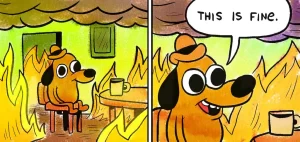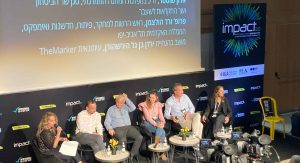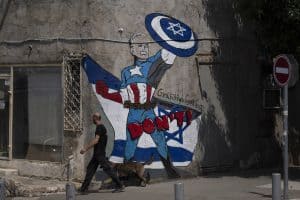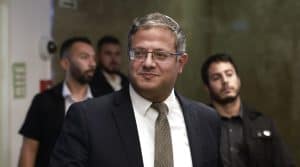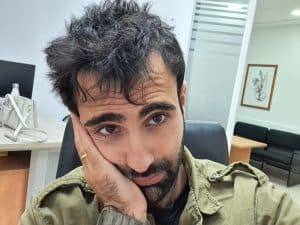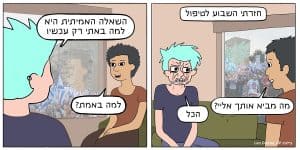[first picture]The key to Judaism for the future generations
On a late August afternoon, a group of young people in their twenties gathered in the library of a kibbutz in the Jezreel Valley. The small library was packed. The old air-conditioner struggled to fight off the thick heat of late summer in the valley. And if this were not enough, a loud drumming class for the kibbutz children was being conducted in the next room. But not a single mobile phone rang. No fingers tapped text messages under the table. No one looked at the clock, fidgeting. These curious young people were participating in the “Study Month” project, a program of Jewish learning held each year for army graduates. The program, which runs for about five consecutive weeks leading up to Yom Kippur, addresses subjects pertaining to Judaism, pluralistic Jewish identity, Zionism, the pioneering ethic, society and economics. Earlier, they had a class on the social doctrine of Judaism. Now they are sitting with the author, educator and intellectual Yariv Ben-Aharon, and reading sections from the diaries of Hannah Szenes in a class on the pioneering ethic. Ben-Aharon will be 80 this year. His father, the former minister Yitzhak Ben-Aharon, a leader of the workers’ movement in Israel, is associated with the generation the young people are now learning about. His son, Avishai BenAharon, coordinates the “Study Month” project, which operates under the auspices of the Beit Berl Foundation, Beit Yigal Allon and the Midrasha at Oranim. The idea underlying the project is actually a proposal for a Jewish-Zionist identity for the young people who live here, in Israel, and who wish to continue living here – without relinquishing their secularity. Avishai explains that a considerable amount of blame for the lack of such identity can be attributed to the education system. “A graduate of the general education system leaves with almost no tools with which to define his Israeli and Jewish identity,” he explains. “He is unfamiliar with the sources, does not know what his roots are, and does not understand why he is living in Israel of all places. Most of the time, his identity is led by and subject to the influence of the media, the general social mood and changing fashions.” In his view, the Study Month offers his students a new possibility: “Our graduates learn about the generation of pioneers who built the state, understand their motives and the sources that drove them, and more importantly, they learn that Zionism is a step, an additional tier in the Jewish heritage. The moment we disengage from the sources and relinquish familiarity with the world of Jewish content, the moment we ignore the inception of pioneering Zionism as part of the cultural continuum of our people – there is no meaning to our life here in Israel, even if we speak about values of sharing and equality, or other lofty values.” Avishai is in his late twenties. Despite his young age, he willingly accepts and adopts the weight of the family heritage laid upon his shoulders. As expected, he is well-versed in the sources and can quote from the writings of Rabbi Judah the Prince and Rabbi Yochanan, together with the ideas of Martin Buber and the poetry of Natan Alterman. He lives in 85 a cooperative community in Haifa with his spouse, and coordinates the Hehalutz movement, an educational movement in the spirit of humanistic Zionism and the values of Israel’s Declaration of Independence. “I feel at home in this world, I grew up within it, but I am not uncritical. My grandfather rejected the Jewish world in which he grew up so he could fulfill the vision of the Zionist revolution and build this country. My father’s life work was, and still is, to renew the bridges between Judaism and Zionism, and to develop the possibility for the secular public in Israel to be Jewish and humanistic. My role in this chain is to nurture a generation here that will not have to relearn where it came from and what its roots are, a generation that will choose to be Jewish, a generation that will study the social, culture and moral implications of our heritage, a generation that will know that the Jewish bookcase includes, alongside the Bible, the writings of Berl Katznelson, the songs of Meir Ariel and the tractates of Yariv Ben-Aharon.” That same day, on Shadal Street in Tel Aviv, a group of ten men and women gathered to read the Talmud together. They have been meeting together daily, at the same hour, nine o’clock in the morning, for over three years already, and study about half a page of Gemara. The students include Dr. Avraham Ahlama, a chemist in his seventies and a member of the Meretz party. In the past, he looked for places where he could study Judaism and become familiar with the sources. Thus, he took academic courses on Jewish thought, even though he is a scientist. In this way, he arrived at the Conservative synagogue in Rehovot, despite the fact that he is not a believer. “I don’t need the assumption of God’s existence. I have no need for this concept,” he explains. “Judaism for me means ethical approaches such as tikun olam [repairing the world], and I see in Judaism a culture and not commandments of dos and don’ts.” He interrupts himself for a moment to clarify: “It is important that this is not my interpretation, but Bialik’s.” The main benefit derived from the group study – conducted in an atmosphere of mutual enrichment in which each of the participants contributes from his cultural store of knowledge – is expressed in two main focal points. As Ahlama explains, “Familiarity with the Jewish sources enables me, among other things, to see the complexity of halacha [Jewish religious law] and to recognize within it the capitalist, racist and discriminatory components, and to separate them from the sources themselves. I learn in this way about ancient Judaism, about its development and what I wish to correct in it. And secondly, the study for me is a value in itself, a value that gives me freedom.” This freedom, together with his familiarity with the sources, has enabled him in recent years to conduct the memorial services for his family in the spirit of Judaism and to supplement the traditional texts with poems and later commentaries, while making sure to include the women in his family in reciting the kaddish. “I am sometimes stunned by the rabbinical rulings from that time, heavyhanded rulings that strengthen the status of the rabbis but discriminate against women and the weak.” And still, he emphasizes, even when the rulings are not consistent with the mainstream view of the rabbis, he and his colleagues insist on including them in the commentaries, as part of the interpretations. The group Ahlama participates in was founded by Kobi Oz, known as the lead singer of the band Teapacks. Several years ago, Oz started a journey into the depths of the Talmud in the framework of a secular study group of musicians led by MK Dr. Ruth Calderon at Alma, a secular center of Jewish learning. At the end of the academic year, Oz asked Alma College to continue the learning and form a secular hevruta [study partnership]in a group format, under its auspices. A group of several dozen students joined him most of them over forty and the circumstances that led them to the group being varied. Around nine o’clock in the morning, they convene in a small room at Alma College, and each time a different person reads. Today it is Oz’s turn. He begins at the place where the previous reading stopped. Soon after the lesson starts, a Breslav Hasid enters the room. He joins the round table where women and men study together. He appears to be a stranger to the group. Oz offers him a chair and informs him that the discussion is about discarding sewage on Shabbat, from the Eruvin tractate. As long as the study is unrestricted and no one tries to lead the discourse in a particular direction, everyone is welcome – that is the bottom line. The learning soon turns into a topical discussion on the excessive use of water, on dwindling natural resources and on the culture of plenty that wastes these resources. Oz seeks to clarify that despite the natural desire to place what they are learning in a current context, this is not the objective. “When people study Judaism, their perspective is often consumer-like, it focuses on what I can take from this for my life,” he explains in our conversation at the end of the lesson. “They approach the Gemara as if it were a supermarket product that you take home with you. But in this study group, we have embarked on a long, marathon journey, which began about four years ago and will end in about ten years, at the conclusion of the learning.” For Oz, it is not only a matter of gaining familiarity with the world of ancient Jewish content, but a broad social effort whose roots are ethnic and whose aim is the possibility of a profound understanding of Judaism’s sources of knowledge, and a connection to the family framework and roots that early Zionism sought to blur, those which were amalgamated under the “Israeli” roof. As he defines this: “From the discourse on globalization and the process that a person experiences in the post-modern era, I felt the need not to be a citizen of the world but rather to connect to my family, to the ethnic group from which I came, to the roots of Grandpa and Grandma and their family –without losing my secular identity. We study everything here, there are pages that are boring and there are those that are fascinating. Our sages were funny people, annoying and wonderful, all at the same time. We encounter the text with respect and love.” While Alma College and the “Study Month” project embody different practices, both reflect the maturation of the same longterm process, the “evolution” of the secular person in Israel who does not seem willing to be satisfied with the model of the barefoot, fighting sabra. Instead, he is searching for a more profound identity – one that is based on Jewish roots, but is not bound by halacha; one that recognizes Zionism as a development of the Jewish world, but knows how to be critical of its founders. This is in fact an open invitation, a proposal for the secular Jew to adopt a free, humanistic, historical and cultural Jewish identity. This secular Jew will occasionally bemoan the young people who leave for Berlin, but cannot always explain why it is better for them to live in Israel. He defines himself as a humanist, but usually refrains from addressing the values of Zionism, leaving this for the ideological right. He waives the understanding that his cultural development – the language, the songs, the calendar and the customs of life – is part of the Zionist enterprise, part of the chain of historical Jewish development, and he abandons the Bible to the Orthodox. He is the silent majority. When Yitzhak Ben-Aharon died, there was a small Bible at his bedside from which he read every evening, with bookmarks in it. One of them marked the vision of Isaiah: “And they shall beat their swords into plowshares and their spears into pruning hooks. Nation shall not lift up sword against nation. Neither shall they learn war anymore.” His son Yariv Ben-Aharon says that this is the heritage his father chose to leave behind when he departed from the world. “The bookmarks he left are with me. In the Jewish bookcase. Part of me.”
[second picture]The prophetic vision, between bereavement and failure
In the 1960’s, the Shdemot magazine, a quarterly edited by Avraham Shapira (Patchy), a member of Kvutzat Jezreel, was published. The members of the editorial board, who became known as “the Shdemot circle,” studied, researched and wrote about the Jewish sources and those of the Zionist pioneers [halutzim], and sought to offer the kibbutz movement a new-old cultural foundation, a return to the Jewish bookcase from a secular perspective. Among the prominent writers were Muki Tsur, a member of Kibbutz Ein Gev, and Yariv BenAharon, then a member of Kibbutz Givat Haim Meuhad. “This group brought together people from the margins of the kibbutz movement who were looking for the human encounter, the other,” Ben-Aharon remembers. “I also felt like an outsider in the Kibbutz Hameuhad [movement]of those days, perhaps even under the rubric of the crazy person. When I came to meetings of this group, I saw that the ideas racing inside of me, and which I felt were exceptions to the norm, took on life.” Muki Tsur, who became an author and historian of the kibbutz movement, found openness and depth there that excited him. “You could talk about anything, without detracting from the challenge of the study and learning together,” Tsur says. “This combination, of sensitivity and depth and the mission-oriented aspect, was important to me and pulled me into being part of the group.” But as it became more cohesive, they incurred incessant criticism because the content they discussed was foreign to the kibbutz movement. “Those who march at the side of the trail are prepared to absorb the dust,” Tsur says, quoting Benny Marshak, one of the founders of Kibbutz Givat Hashlosha. “And we got hit by dust, from both the secular public for dealing with exilic sources, and from the religious public for the secular reading of the Jewish sources.” Dr. Alon Gan, a historian who studies the shaping of Israeli identity, explains that the Shdemot circle sought at the time to provide a response to the crisis of identity in Israeli society, which began in the transition from a Jewish-pioneering Yishuv to an organized state, and continued in the 1960’s in the wake of two identity-shaking events: the Eichmann trial and the Six Day War. “The Eichmann trial was, in fact, the first opportunity for the Israeli sabra to hear testimonies of Holocaust survivors, not the testimonies of partisans, in an encounter that shook his soul. As Haim Guri said at the time, “No one will leave here similar to himself.” Gan believes that the shock from the encounter with the testimonies intensified during the “waiting period” – the tense days prior to the Six Day War. “The feelings during that period forebode destruction, a real fear of victory by the Arab armies. The Israeli public experienced the ancient Jewish fate for the first time, the same constant threat that was rooted in the exilic Jewish culture over the generations. For the first time, the public discourse used the words “extinction” and “extermination” in the context of current events, words that were foreign to the sabra’s Zionist terminology up until that period.” The winds of the period, therefore, should have given the Shdemot circle a strong foundation for a revolution in the kibbutz movement, a cultural revolution that should have strengthened the cooperative idea and spawned new leadership in the kibbutzim, and from there rising permeating all of Israeli society. But during the ensuing decades, the kibbutz movement shed its spiritual assets and experienced a crisis from which it has yet to emerge. Only one sapling sprouted from the mythological Shdemot group: Tsur and BenAharon created an array of multidisciplinary ideological workshops in the 1970’s for counselors in the kibbutz movement, in the spirit of the magazine. “In effect, we continued the same pattern from the Shdemot period,” Ben-Aharon says. “I taught lessons about the Talmud and creative works by Zionist pioneers, Muki taught about the heritage of the Zionist pioneers, and they were incorporated in a group dynamic led by Aviva Zamir.” The uniqueness of the workshops, they say, was in combining the traditional content – the Bible, Mishnah, Talmud, medieval poetry and modern Jewish philosophy – with content from the Zionist pioneers. Tsur explains that not only the combination of sources was revolutionary, but also the method of learning: “When one of us taught, the other teachers actively participated in the process as part of the group of students and together we searched for the path.” In his view, the central point was not at all connected to the content, but to the connections created in the groups. “We checked at the end of each process whether the learning increased the depth of the dialogue among us, whether it strengthened the ties of the groups, whether learning partnerships were formed. We did not have a hierarchy of knowledge. Everyone learned from everyone. This is substantially different from the process of learning in the rabbinical world or in the world of academic instruction.” The workshops became popular and attracted members from throughout the kibbutz movement. Dr. Moti Zeira, a member of Kibbutz Givat Haim Ihud, came to the workshops at the kibbutz movement-owned Ramat Efal seminar center after completing his army service. The kibbutz movement was undergoing a metamorphosis in those days. The acute crisis in Israeli society reached the kibbutzim, pervading the bylaws and the dining hall, and eroding the social structure and resoluteness of spirit. “Members around me, veterans of the tough battle of Yom Kippur, emigrated from Israel,” he says. “Young people with a biography similar to mine, with answers identical to those I held, decided not to live here any longer. I was taught all my life to say that I’m an Israeli, a native son of this land, that I speak Hebrew and serve in the army – components that were meant to suffice for building a complete identity in Israel – but when I was released from the army, I felt it inconceivable that this identity was based on secular jokes and struggles over the closing of a movie theater and mall on Shabbat. I had to know why I was staying, I had to give myself complex explanations that would hold up against the emigrants calling for me to join them.” “It is important to understand that the social breach that occurred in the wake of the Yom Kippur War and the decline in the power of the labor movement as a formative ethos, eviscerated the sabra Israeli identity,” adds Gan. He also notes that the peak of the crisis of identity came with the dramatic turnabout in the 1977 elections and the right’s rise to power. “Among wide swaths of Israeli society, the feeling of alienation grew, along with the fear that the state was becoming right-wing and nationalistic. This reality increased the need for a new Jewish-secular identity based on the foundations of the Zionist pioneers.” Not only emigration from Israel served as a comfortable solution for those who felt this alienation and searched for a way to contend with the difficult question of identity. Religion also offered an answer and, in particular, emotional peace, for members of that confused generation. “I saw Uri Zohar change before my very eyes,” Zeira says, recalling his favorite cultural hero who began to wear a yarmulke and fringes [tzitziyot]during his work as the host of a television quiz show (“This is My Secret”), until he left the entertainment world entirely in 1997. “The Lool gang was for me the most Israeli humor there was,” Zeira reminisces. “They showed sandals and short pants on television, new Israeli music, local filmmaking and a complete cultural language that I was a part of, [a cultural language]that was an object of emulation. Today, that same admired actor stands before me with a yarmulke and explains that my culture is not sufficiently spiritual and deep.” For Zeira and those of his generation, the idea of conducting a different and new discussion on questions of secular-Jewish identity was appealing and reflected a real need for answers, or at least a place where it was possible to ask questions. The Shdemot group failed in its day, but the vision, like the biblical prophecy, comes to pass many years later. Graduates of the ideological workshops, including Zeira, founded the Midrasha at Oranim in this same spirit. This Midrasha was the first secular educational center to tackle questions of the identity of Israelis and their connection to Judaism. The founders of Alma College and the creators of the “Study Month” project also struck their roots at this educational center.
[third picture]A song for a weekday, between Sabbaths and holidays
This article’s endeavor to define the evolving secular-Jewish Israeli identity as a stream ran into a number of difficulties. Each ideological group we interviewed sought to explain how it differs from the others. And here, in contrast to the religious streams, there is no halacha that unites the secular Jews living in Zion; there are no bylaws or rabbis to determine who belongs to the community and there is not even agreement over “who is a secular.” The journalist Yair Sheleg called the renewed Judaism, “the fourth stream.” However, the definition “renewed Judaism” in itself did not engender consensus. The past decade has seen a dramatic increase in community and social initiatives for events of renewed Jewish culture. They are all characterized by unrestricted learning, alternative ceremonies and community activities, particularly related to Kabbalat Shabbat [welcoming the Sabbath on Friday evening]. The older examples include the Nigun Halev community in the Jezreel Valley, founded by Shai Zarchi, another graduate of the Ramat Efal workshops. The community he formed brings together families and individuals from throughout northern Israel and was among the first to carry out the vision of the Midrasha at Oranim outside of the kibbutz environment. A similar group, Beit Hatfila Haisraeli, operates in Tel Aviv. While its roots are in the Reform movement, the community itself includes hundreds of secular Israelis from throughout the city who have been conducting pluralistic community Kabbalat Shabbat programs with hundreds of participants for over a decade. In addition, there is a network of about thirty learning communities [batei midrash]for the study of renewed Judaism, including Beit Elul, Kolot, Tmura and more. And, as is typical in the Jewish world, the dissimilarities are greater than the similarities, and the debate along the path is long – at least as long as the history of Zionism – and growing. Among the key organizations engaged in shaping a new Jewish identity are dozens of cooperative groups and urban kibbutzim, spread throughout Israel and maintaining an identical model of collaboration, a collection of groups. The members of the groups and kibbutzim are usually graduates of the youth movements and the pre-military preparatory programs who meet during their year of service – a year of educational or charitable work and study prior to their army service. Most of them enlist as groups in the Nahal Brigade. But unlike the classical missions of such Nahal groups in the kibbutz movement, its graduates form new initiatives. “The educational movements combine the mission-oriented world of Zionist pioneering, study of the Jewish bookcase, formulation of life milestone ceremonies in a liberal spirit, with a spiritual layer of heartto-heart conversations and group dynamics,” explains Gan. He calls this developmental stage “Judo-realistic,” a Jewish-sabra mix. The first seeds of the idea of collective renewal sprouted somewhere in the 1980’s, during the period of massive privatizations that swept Israeli society, along with the deep crisis in the kibbutz movement. Pesach Hauspeter, the secretary-general of the Dror Israel movement – comprised of graduates of the Hanoar Haoved v’Halomed movement – was among the leaders of this process. “The great thing that the Shdemot group did was to make the Jewish sources accessible and to create the feeling that these sources are ours – the Bible and the Babylonian and Jerusalem Talmud, this whole enormous ocean. And I think the Shdemot group performed an extraordinary social, cultural and spiritual act. Hauspeter – who was one of the leaders of the struggle over lands, and under whose leadership the movement played an active role in the 2011 summer of protests – sees a direct connection between the sources of Judaism and social struggles. “Our problem in Israeli society, in the State of Israel’s current situation, where the demand for justice does not exist, and I say this in pain, is the very deep assimilation of the Jewish people,” he argues, and turns to the sources: “They ask why the Second Temple was destroyed. The common response is because of jealousy and such, but to a great extent it was the social disparities that became intolerable and engendered the awful extremism, which led to the destruction. Anyone with eyes in his head sees that a view of Judaism that is not based on the values of justice and equality among people is idol worship. And idol worship, history teaches us, ultimately results in the land spitting us out. Unfortunately, that is the situation we are galloping toward today.” In his view, Jewish fulfillment is not in aspiring or praying, or in the next life, but rather in life itself: “The far-flung word in the Hebrew language called ‘fulfillment’ is the ability and the desire, the readiness and the daring, to fulfill things, in actual practice and in the life of here and now. The cooperative idea, expressed in the establishment of the Histadrut labor federation, for example, is the refined expression of the Jewish perspective that Martin Buber cites – ushering in the spirit and actualizing morality and justice in the reality of life.



